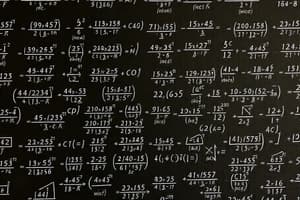Podcast
Questions and Answers
What is the correct order of operations to solve an expression?
What is the correct order of operations to solve an expression?
- Multiplication, Division, Parentheses, Exponents, Addition
- Parentheses, Exponents, Multiplication, Addition, Subtraction (correct)
- Parentheses, Multiplication, Addition, Exponents, Subtraction
- Addition, Subtraction, Multiplication, Division
What does a variable represent in algebra?
What does a variable represent in algebra?
- A symbol representing numbers (correct)
- A fixed number
- An equation that is always true
- A combination of numbers and operations
Which geometric property is used to calculate the size of the inside of a shape?
Which geometric property is used to calculate the size of the inside of a shape?
- Volume
- Perimeter
- Diameter
- Area (correct)
Which measure is used to identify the middle value of a data set?
Which measure is used to identify the middle value of a data set?
What is the primary purpose of the unit circle in trigonometry?
What is the primary purpose of the unit circle in trigonometry?
In the context of statistics, what is a qualitative data type?
In the context of statistics, what is a qualitative data type?
What is the main purpose of calculating a derivative in calculus?
What is the main purpose of calculating a derivative in calculus?
Which term refers to the smallest positive integer that is a multiple of two or more integers?
Which term refers to the smallest positive integer that is a multiple of two or more integers?
In set theory, what operation combines elements from two sets without duplicates?
In set theory, what operation combines elements from two sets without duplicates?
What is the approximate value of Euler's number (e)?
What is the approximate value of Euler's number (e)?
Flashcards are hidden until you start studying
Study Notes
Basic Concepts in Mathematics
-
Arithmetic
- Operations: Addition, Subtraction, Multiplication, Division
- Order of operations: PEMDAS (Parentheses, Exponents, Multiplication and Division, Addition and Subtraction)
-
Algebra
- Variables: Symbols representing numbers
- Expressions: Combinations of numbers and variables (e.g., 3x + 2)
- Equations: Statements of equality (e.g., 2x + 3 = 7)
- Functions: Relationships between variables, often expressed as f(x)
-
Geometry
- Shapes: Circles, triangles, squares, polygons
- Properties: Perimeter, area, volume
- Theorems: Pythagorean theorem, properties of angles (e.g., complementary, supplementary)
-
Trigonometry
- Ratios: Sine, cosine, tangent
- Right triangles: Relationships between angles and sides
- Unit circle: Circle of radius 1 used to define trigonometric functions
-
Statistics
- Data types: Qualitative vs. quantitative
- Measures: Mean, median, mode, range
- Probability: Likelihood of events occurring, calculated as favorable outcomes over total outcomes
-
Calculus
- Limits: Approach of a function as it nears a point
- Derivatives: Measure of how a function changes as its input changes
- Integrals: Area under a curve, accumulation of quantities
-
Number Theory
- Properties of integers: Even, odd, prime, composite
- Divisibility rules: Conditions under which one number can be divided by another without a remainder
- Greatest common divisor (GCD) and least common multiple (LCM)
-
Mathematical Logic
- Statements: Propositions that can be true or false
- Logical operators: AND, OR, NOT
- Proofs: Methods of demonstrating the truth of mathematical statements (e.g., direct proof, contradiction)
-
Set Theory
- Sets: Collections of distinct objects
- Operations: Union, intersection, difference
- Venn diagrams: Visual representation of set relationships
Key Mathematical Tools
- Calculators: For computations and graphing
- Graphs: Visual representations of functions and data
- Software: Tools like MATLAB, Python, and Excel for complex calculations and modeling
Important Mathematical Constants
- π (pi): Ratio of a circle's circumference to its diameter, approximately 3.14
- e (Euler's number): Base of natural logarithms, approximately 2.718
Problem-Solving Strategies
- Understand the problem: Read carefully, identify knowns and unknowns
- Develop a plan: Choose a method or formula
- Execute the plan: Calculate step by step
- Review/reflect: Check for accuracy and reasonableness of the solution
Arithmetic
- Fundamental operations include addition, subtraction, multiplication, and division.
- Order of operations is governed by the acronym PEMDAS: Parentheses, Exponents, Multiplication and Division (from left to right), Addition and Subtraction (from left to right).
Algebra
- Variables are symbols (like x or y) that represent numbers in mathematical expressions.
- An expression is a combination of numbers and variables, such as 3x + 2.
- An equation is a statement asserting the equality of two expressions, e.g., 2x + 3 = 7.
- Functions establish relationships across variables and can be represented as f(x).
Geometry
- Basic shapes include circles, triangles, squares, and various polygons.
- Essential properties to consider are perimeter (the length around a shape), area (the space contained within a shape), and volume (the space contained within a three-dimensional object).
- Important theorems include the Pythagorean theorem and properties concerning angles such as complementary (sum to 90°) and supplementary (sum to 180°).
Trigonometry
- Key trigonometric ratios are sine, cosine, and tangent, which relate the angles and sides of right triangles.
- Right triangles feature crucial relationships between their angles and side lengths.
- The unit circle, a circle with a radius of 1, is critical for defining trigonometric functions.
Statistics
- Data is categorized into qualitative (non-numeric) and quantitative (numeric).
- Key measures of central tendency include mean (average), median (middle value), mode (most frequent value), and range (difference between highest and lowest values).
- Probability assesses the chance of events, calculated as the ratio of favorable outcomes to total outcomes.
Calculus
- Limits describe how a function approaches a specific point as its input nears a value.
- Derivatives measure how a function's output changes in response to changes in the input.
- Integrals calculate the area beneath a curve, representing the accumulation of quantities.
Number Theory
- Key properties of integers include classifications as even (divisible by 2), odd (not divisible by 2), prime (only divisible by 1 and itself), and composite (has divisors other than 1 and itself).
- Divisibility rules dictate when one integer can be evenly divided by another.
- GCD refers to the greatest common divisor, while LCM denotes the least common multiple of a set of numbers.
Mathematical Logic
- Statements, or propositions, can either be true or false.
- Common logical operators include AND (both conditions must be true), OR (at least one condition must be true), and NOT (negation of a condition).
- Proofs are structured methods to validate mathematical statements, with techniques such as direct proof and proof by contradiction.
Set Theory
- A set is a collection of distinct objects, defined by its elements.
- Key operations involve union (combining sets), intersection (common elements), and difference (elements in one set but not in another).
- Venn diagrams visually illustrate the relationships between sets.
Key Mathematical Tools
- Calculators assist in computations and graphing functions and data.
- Graphs serve as visual aids for understanding functions and relationships in data.
- Software tools like MATLAB, Python, and Excel facilitate more complex calculations and mathematical modeling.
Important Mathematical Constants
- π (pi) represents the ratio of a circle's circumference to its diameter, approximately valued at 3.14.
- e (Euler's number) is crucial in calculus as the base of natural logarithms, approximately valued at 2.718.
Problem-Solving Strategies
- Initially, understand the problem by carefully reading it and identifying knowns and unknowns.
- Formulate a plan, selecting appropriate methods or formulas for solving the problem.
- Execute the plan methodically, calculating step by step.
- Conclude by reviewing the solution for accuracy and ensuring it is reasonable.
Studying That Suits You
Use AI to generate personalized quizzes and flashcards to suit your learning preferences.




